

 The South African
The South African
* The Rietfontein 17 miles [28km] west of Pretoria.
About the author: Ian Copley was previously Head of Neurosurgery at MEDUNSA and National Chairman SAMHS. Now he is officially retired but working at the Livingstone Hospital, Port Elizabeth. He served in the Royal Army Medical Corps in the British Army in Kenya, Kuwait and Swaziland in the sixties and the Rhodesian Army Medical Corps in the seventies. In the South African Medical Service, he started the first separate Defence Force neurosurgical and rehabilitation service at 1 Mil Hosp, Pretoria, during the eighties. Other interests are Early Medieval History, aviation and the piano works of Eric Satie.
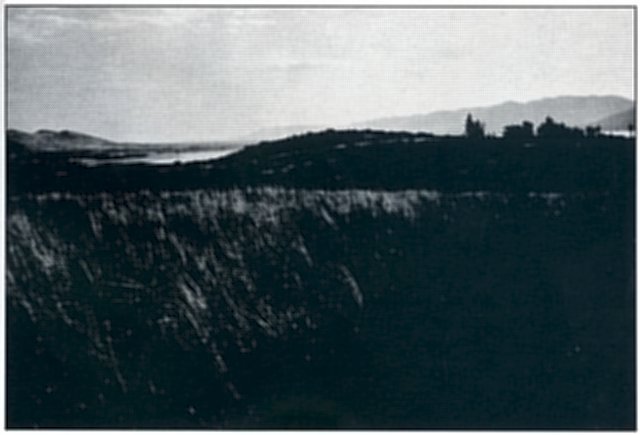
Rietfontein Hills from the easternmost hill.
(Photo: I B Copley).
Introduction
The military complex known as Rietfontein West 'disappeared' and, until recently, its whereabouts were only known to a few people. One of these, a descendant of General Schoeman, sold the site for housing development, which, despite protests and omission of an environmental impact study, went ahead. Indeed, the location of the consolidated Military Cemetery of that name was difficult to find and this was part of the reason for it falling into neglect at one time, since the local council were unaware of their responsibility to look after it. The cemetery is now surrounded, and the developers had to be notified of their obligation to provide suitable access to it, but they could not be persuaded to give historical associations to the new street names. Two-thirds of Gun Hill was already built over.
The farm Rietfontein was immediately east of the Hartbeespoort property owned by General Hendrick Schoeman. The ridge of low hills there attracted the attention of the first British forces in the area during the South African War (1899-1902). From a bivouac site for General French's flanking cavalry force after the engagement at Kalkheuwel Pass on the way to outflank Pretoria in June 1900, it developed within a few months into a fortified communications post, then a garrison and convoy depot complete with batteries of guns and medical facilities.
The guns could control the adjacent passes of Commando Nek and Silkaatsnek in the Magaliesberg, as well as the all-weather road between Pretoria and Rustenburg, the telegraph Ijne and the rickety 'Paul Kruger' bridge over the Crocodile River on the Schoeman farm. The site merited a hospital for casualties from the camp and surrounding garrisons as well as casualties in transit from events in the Western Transvaal, saving them the trauma and a further day's travel by wagon to reach the Pretoria hospitals.
Rietfontein West thus came to be regarded as the key to the Western Transvaal and to the Magaliesberg region during the guerrilla phase of the war.
The geographic site
The Rietfontein military camp developed on two of a chain of four low hills, a diabase outcrop with shale, rising from the floor of 'Die Moot', or valley south of the Magaliesberg, which runs parallel to it from east to west. The southern margin is sheltered by the Witwatersberg. The chain or ridge is over two kilometres in length and emerges as the valley floor starts a gentle descent towards the Crocodile River, which flows northwards through a gorge [now Hartbeespoort Dam] at the east end of the Cosmos fault line. Commando Nek, an easy pass for wagons, follows the western fault line so that the whole Cosmos block of the Magaliesberg leans to the south like a snag tooth. Silkaatsnek is equidistant from the gorge to the east.
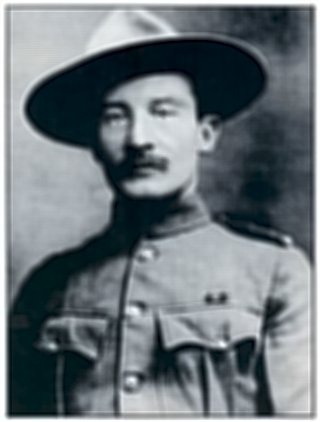
Colonel R S S Baden-Powell.
(Source: Wilson, With the Flag to Pretoria).
The first hill from the west is 'Gun Hill' [1 215m] and is next to 'Camp Hill', which is flatter and more symmetrical. The third hill supports the largest area of relatively level ground, whilst the fourth hill is the highest, at 1 243m; the latter two hills could provide adequate space for convoy parks. The four hills are bisected equally by the modern R511 road at a point 5km due south of Silkaatsnek.
Gun Hill has a commanding view over the Crocodile River and along the Moot to Commando Nek [7km], Klein Nek and distant Nooitgedacht. The hill descends as a long spur to the banks of the river near which stood General Schoeman's farm, a kilometre or so short of the bridge, which, at the turn of the century, accommodated the allweather Pretoria-Rustenburg road via Commando Nek. The remains of the farm and bridge are now normally below the waters of the Hartbeespoort Dam.
To the south, the hills are separated from the Witwatersberg by the Swartspruit, the likely water source for the camp.
Rietfontein was a large farm occupying the floor of the Moot on the east bank of the Crocodile River, opposite Silkaatsnek as it appears on the Jeppe Map of 1899, east of the Hartbeespoort property owned by General Hendrick Schoeman. The name is first mentioned in the regimental diary entry of T Battery, Royal Horse Artillery (RHA) for 4 June 1900, as it was where they had bivouacked. The battery had just emerged with distinction from the ambush at Kalkheuwel Pass the day before, being part of General French's cavalry wing making the western flanking movement on Pretoria. A note mentions that it was a 'very nice valley'. Which of the four hills the battery used is not stated, but Camp Hill would have been of easy access before continuing towards Silkaatsnek the next day. Other accounts only mention the left bank of the river, General Schoeman's farm, or the two passes.
Baden-Powell's headquarters
For the first two weeks, Rietfontein was used intermittently as a naturally fortified bivouac site when the 2nd Bn Lincolnshire Regiment (Lincolns) stopped there on 16 June before marching over Commando Nek with General Hutton's mounted infantry (MI) and Colonial MI to meet Colonel RSS Baden-Powell at Bokfontein Camp, immediately north-west of Commando Nek. 'BP' returned to Pretoria with the Lincolns and two guns of 18 Battery, Royal Field Artillery (RFA).
It was Baden-Powell who first recognised the broader military significance of the first two hills at Rietfontein in relation to the road, the bridge, the two passes and its position between Pretoria and the Western Transvaal. On 2 July he had occupied Silkaatsnek and Commando Nek, keeping the rest of his force midway between the two neks at Rietfontein. He commented upon the inadvisability of keeping small forces in the neks. It is probable that he had the defences constructed at Rietfontein, generally known as 'Baden-Powell's HQ Camp', during his first visitr or during his stay from 6 to 19 August 1900, when he was at Commando Nek with 1 100 men under his command. The region was then back under military control, having been lost on 11 July at the battle of Silkaatsnek (Copley, 1993, p 87) and retaken in the second battle on 2 August (Copley, 1995, p 63). Baden-Powell's presence at Commando Nek prevented a sortie on poorly-defended Pretoria on 17 August by General de Wet.

No 39 Field Hospital next to the Pretoria - Rustenburg road
(Source: Howe, Countess, (ed), Imperial Yeomanry Hospitals,
Humphries London, 1902)and below the view today.
The Royal Scots Greys arrived at the 'small kopje in the middle of the valley' on 8 July 1900. They were there to relieve Baden-Powell, having marched from Derdepoort, north of Pretoria, along the north face of the Magaliesberg. A squadron was installed at each nek and Colonel Alexander's headquarters at Rietfontein, with two 12pounder guns of '0' Battery, under Major Jervis-White-Jervis. On 11 July, from this position, they failed to render adequate support to the Lincolns, who had just arrived the night before to take over from the Greys and the RHA. Before the end of the engagement and the surrender of the Lincolns, Col Alexander abandoned the camp, withdrew the Greys and RHA from Commando Nek, ran into the erstwhile relieving force, and returned with them to Pretoria (Copley, June 1993, p 93).
On 25 July, Col T E Hickman came out from Pretoria to reconnoitre the neks with 2 Bn Duke of Cornwall's Light Infantry and 18 Battery, RFA. The Boers were noted to have a laager in the area and to be on top of the passes. As the Crocodile River was in flood, they returned to Pretoria.
The second battle of Silkaatsnek was fought on 2 August. General Ian Hamilton made Rietfontein his headquarters. The Argyll & Sutherland Highlanders (ASH) attacked the Nek and kopje frontally, whilst the Royal Berkshire Regiment stormed the eastern buttress. pte W House of the Berkshires was awarded the Victoria Cross for rescuing his mortally-wounded sergeant (Copley, 1995, p 63). The Highlanders lost one man and the Berkshires, five, possibly the first direct interments at Rietfontein.
By 15 August, Baden-Powell had 1 480 Mounted Infantry (MI) plus an infantry battalion on Commando Nek. The MI was relieved by the King's Own Yorkshire Light Infantry (KOYLI) on the 17th. On the 19th, General Mahon was operating from Bokfontein, just beyond Commando Nek, whilst Ridley's MI Brigade, sent by Kitchener, was approaching Wolhuter's Kop, some 5km further along the Rustenburg road. Major Urmston, with a detachment of ASH, was escorting a convoy with supplies for General Hamilton, guarded by two Elswick guns and 50 MI, who had just left Commando Nek and had almost cornered General de Wet. The Boer general had been obliged to escape over the Magaliesberg by a little-known route 'suitable for baboons', which lay further west, close to Klein or Pampoen Nek. De Wet had found Commando Nek guarded by the Border Regiment, which had been left there by Hamilton under Baden-Powell, whilst the ASH were at Silkaatsnek, later to be replaced by the second half of the Border Regiment.
General Kitchener, returning from Rustenburg, reached Wolhuter's Kop on 22 August and marched over Commando Nek to Rietfontein the next day (Maurice, 1908, p 371). In this column was Major G L Crossman of the West Yorkshire Regiment, who mentions in his diary (p 45), that it was a 'very pretty road through Commando Nek and over the Limpopo or Crocodile River'. He notes the windy conditions and that it was very hot when they reached Rietfontein 'about noon' but had nothing to say about the camp.
The arrival of medical units at Rietfontein
From 1 September, General Clements, operating from Commando Nek, was responsible for clearing the country north and south of the Magaliesberg of local supplies, stock and marauding bands (Maurice, 1908, p 372). On 23 September, General Broadwood's Cavalry Brigade and a column of 800 composite infantry, including half of 15 Brigade Field Hospital, which had been sent out from Pretoria towards Rustenburg in support of Clements against General de la Rey, passed through Rietfontein. This is the first mention of a medical unit in the area, other than individual medical officers (Maurice, 1908, p499).
Cunningham's force travelled via Rietfontein from Pretoria to Rustenburg with the 75 Bty RFA, 1 Elswick Battery, 2nd Bn West Yorks Regt and 1st Bn ASH on 1 October. By 3 October, Generals Clements and Ridley could only travel safely from Rustenburg as far as Commando Nek, since the road from there to Pretoria was infested with snipers. Two spent MartiniHenry bullets found at Rietfontein bear witness to this. The task of clearing the area was given to Colonel A N Rockfort, Royal Artillery, who took with him a small party of 2nd Bn Royal Dublin Fusiliers to deal with a particularly troublesome band of marksmen who specialised in harassing convoys. He succeeded in capturing all but one of them (Maurice, 1908, p 500).
Clements continued searching the Magaliesberg, having the Northumberland Fusiliers on the crest whilst the remainder of his force remained in the Moot. Broadwood's Cavalry, with half of the 2nd battalion KOYLI, searched the foot of the northern slopes where many Boers were winkled out and captured (Maurice, 1908, p 506).
With the continuing activity in the Western Transvaal, Rietfontein became increasingly important, first as a fortified camp and communications post, which was later enlarged to include a garrison of between 700 and 900 men guarding communications and providing facilities, including medical, for a large depot and transit camp. On 19 October, the first return of No 39 Stationary [tented] Hospital was made. It boasted a hundred beds and was to remain there until 31 May 1902. A week earlier, No 38 Rustenburg Stationary Hospital had arrived, remaining for the duration, also with a hundred beds. Nurses at Rietfontein were a Miss J Gibson and Miss L Paul, locally recruited, who had previously served at Green Point in Cape Town (PRO 1901), and Miss L G Kell, an Army Nursing Service reservist, who was later attached to the Irish Hospital (19 General Hospital) in Pretoria (Gray, 1993, p 50).
During November 1900, baggage trains between Pretoria and Rustenburg travelled to and fro, unmolested, until the morning of 3 December, when the outward-bound convoy was attacked opposite Buffelspoort. Casualties amounted to eighteen killed in action and 46 wounded. The units guarding the three-mile [5 km] long convoy were the 2/West Yorkshire Regiment, the Victoria Mounted Rifles and the RFA. The burials are commemorated at Rietfontein, having been removed there in 1972. Five names are unaccounted for. The wounded are likely to have been treated at the nearer Rustenburg facility. Communications with Rustenburg were severed.
From Nooitgedacht, some 50km further west, Clements had sent to Rietfontein for rations on 5 December. The remnants of his column arrived there on the 14th, after the disastrous defeat in battle at Nooitgedacht on 12 December. He was soon able to find reinforcements as his own men, nearly 1 000 strong, who had been garrisoning Krugersdorp, marched into Rietfontein the same day. Also present were the 1 st Bn Border Regt, 200 Mounted Infantry, and two guns of 8 Battery, RFA. Clements was joined by Brigadier E A H Alderson, with 800 MI and 'J' Battery, RHA. The Magaliesberg to the west was in the hands of the enemy again, but, by 16 December, Clements could move out to Hekpoort, 1 Okm west of Rietfontein along the Moot. Many of the remnants of his original column moved into Pretoria to refit, leaving behind one squadron of Kitchener's Horse and half a company of 2 Corps MI, who could then move into the main camp (Maurice, 1908, p 19).
Kitchener's Horse at Rietfontein Camp
As the first eye-witness at Rietfontein camp, there is the diary of Trooper J G B Clayton of Kitchener's Horse [KH], who arrived early in the morning with Clements' remnants from Nooitgedacht and spent a month there (Clayton, 1900, p197). They camped on the valley floor between Rietfontein and Commando Nek for the next two days, resting and endeavouring to cook their food in tins picked up on the veldt. Clayton mentions that the men who had fought in intense heat without food 'drank greedily at every dirty pool and so laid up for themselves much "enteric" as they afterwards found'. In fact, deaths at Rietfontein due to disease began to occur very frequently after 16 December 1900. Since August that year, there had been only two to have 'died of disease' (DOD).
When the ambulances from Nooitgedacht arrived at the hospital, they were emptied of wounded and sent back for more, the great majority of whom had been left behind. On 15 December, an additfonal number of ambulances and doctors was dispatched to Nooitgedacht. Clayton remarks that there was already 'a fairly large garrison of the Worcesters, Ceylon MI, Yeomanry and gunners with a couple of naval guns and half a dozen pieces of Field and Horse Artillery ... Rietfontein at this time was a sort of depot on the direct route to Rustenburg and boasted a daily steam transport service with Pretoria.'
A traction engine with three or four wagons was quicker to deliver and easier to guard than extended convoys drawn by oxen. A plentiful supply of fuel and water was needed and they could only operate on flat ground.
'General Cunningham's column assisted in policing and otherwise making safe the Rustenburg-Pretoria road against the passage of a larger convoy than the one captured at the beginning of the month.'
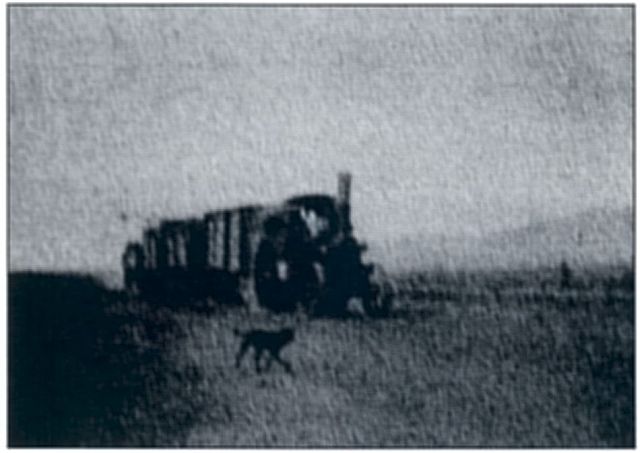
Contemporary photograph by Lieutenant Gibbs, showing the steam traction engine
approaching Rietfontein. The dog's name is 'George'
(By courtesy, Fusiliers Museum of Northumberland)
Clayton spent Christmas Day at the camp, mentioning the blazing heat and the outbreak of horse sickness [which is still prevalent today]. Conditions for the men were not good: 'Soap and towels there were none to be got for love or money and, had not the Worcester Regt presented the rank and file with a few worn-out blankets, a good many would have had to spend their nights out in the open.'
'Things in the officers' lines were no better,' he writes, 'a piece of gun-cleaning rag doing duty amongst three as a towel and although one [officer] was the fortunate possessor of a toothbrush, this he refused to lend. As a counterbalance to the toothbrush ... the happy man possessed no tunic and when on camp orderly duty had to borrow articles of much smaller dimensions from his mess-mates to be at least presentable, which only made him look like Mr Pickwick.'
The camp commandant gave them permission to retire on Pretoria, which they duly did, only to be told to return to Rietfontein as no orders had been issued from Pretoria for the move.
'On 18 January 1901, General Paget's column, which had arrived the previous day, moved off up the Magaliesberg [Moot] and the next day a deluge of rain swept the valley and laid low almost every tent with the exception of the hospital [on lower ground], besides disjointing the traction engine service from Pretoria.'
'Life up to the 19th [December] was very dull, occasional patrols into the bushveldt being all the work done, with occasional outpost [duty]. Three of our wounded succumbed in the local hospital and were buried with Military Honours. Among the number was Q[uarter]M[aster] Sgt Longfield, whose leg and thigh had been badly shattered with an expanding bullet on the 13th. [There are only two other KH deaths recorded between December and the end of January 1901]. Some break in the monotony was, however, afforded by small parties of 6 Corps [MI] re-equipped and rehorsed, continually arriving from Pretoria on their way to join General Cunningham.'
From January, the area west of Rietfontein was relatively quiet, since the centre of activities had moved to the far western and south-western Transvaal. However, Paget and Plumer continued patrolling the Magaliesberg and the Moot to deny the region to General de la Rey.
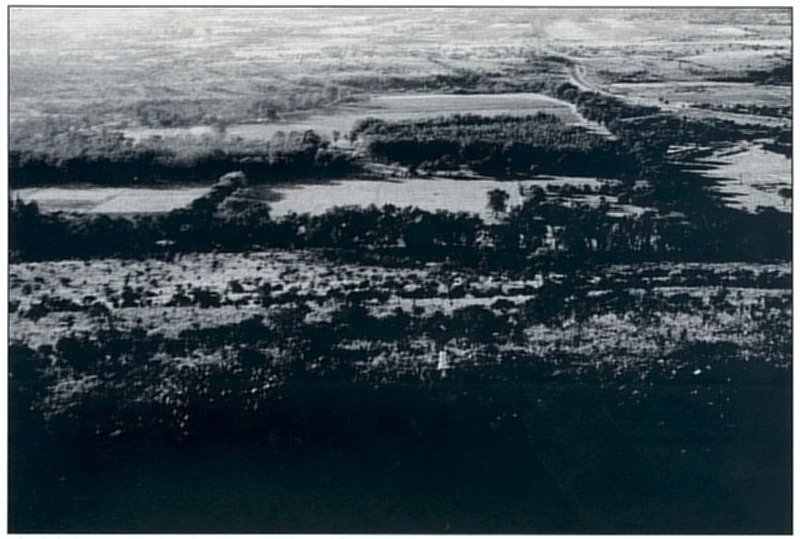
Aerial view north showing the remains of South Hill Fort and Camp Hill,
with Rietfontein visible in the middle distance. (Photo: I B Copley).
Soon after the battle of Nooitgedacht, a 'medical party' arrived on the left bank of the Crocodile River at Groenplaas, west of Rietfontein, on 15 December. They noted that it had been visited the previous August. They reached Rietfontein from the Hekpoort valley, which opens into the Moot in front of Commando Nek, and pitched camp opposite 'Uitvals Nek' [Silkaatsnek]. Half a mile away was a 'stationary hospital under Capt Probyn, RAMC, and a little further off, part of the 12 Bde Field Hospital under Capt Longhurst, RAMC. In the hospital under Capt Probyn, there were many of the wounded from Nooitgedacht'.
A large convoy was expected the next day, necessitating preparations for its reception. At about 22.00 the same evening, Capt Marshall, NSW Ambulance, brought in 82 wounded, including six officers. Sixty were admitted and, presumably, the other 22 continued on their way to Pretoria.
Major Hale, who photographed the tented hospital [Howe, 1902, Vol II, pp 196-7] was SMa; his duties included reception and dispatch of convoys, official returns and telegrams, etc. Sick and wounded continued to arrive, the former gradually outnumbering the latter. [Six casualties died before the end of the month, whereas five died of disease according to the record of burials. In the following month, January 1901, three died of wounds and three died of disease and two by accident on service].
The diary continues: .'For many days large convoys of sick and wounded poured in. The wounded from Nooitgedacht were not all picked up for about five days due to the difficulty of finding some of them among the huge boulders'. Some wounded had 'inflamed and suppurating wounds, which in some instances, were full of maggots'. Some of the bad cases were kept at Rietfontein and so, avoiding the further journey into Pretoria, 'limbs of some and lives of others' were spared.
Work was facilitated by Colonel Gubbins, PMO, Pretoria, with whom they were in constant heliographic and telegraphic communication, asking for supplies to be sent out by the steam 'sapper' or traction engine twice a week. This engine, according to Clayton, ran daily.
The Lincolns
According to the Digest of Service of the 2nd Bn Lincolnshire Regiment, the battalion spent the rest of the war in and around Rietfontein. On 29 December 1900, they had marched out via 'Sandfort', west of Pretoria, to relieve the Northumberland Fusiliers at Rietfontein, Commando Nek and surrounds. They reached Rietfontein the following day, 30 December (Howe, 1902, p 196).
Apart from contributing to the camp defences, the Fusiliers must have been responsible for three forts on the Witwatersberg, 2 miles (3.2 km) south of the Rietfontein hills. These forts were in existence when the Lincolns arrived. There are seven Fusiliers buried at Rietfontein: two killed in action in August 1901, and five who had died of wounds earlier, after the battle of Nooitgedacht in December 1900.
Of the relieving Lincolns, the first five companies, with the headquarters company, passed over Commando Nek to Bokfontein to join General Clements' force at Wolhuterskop. They were replaced at Rietfontein by 'C', 'E' and 'H' companies arriving from Pretoria a day later. The battalion returned on 6 January 1901. Meanwhile, 'H' Company had been sent to occupy the fort at 'South Hill', beginning a rotation of companies between the fort and Commando Nek. It is strange that there is no reference to the entire stay of the second battalion at Rietfontein (Lee, 1911).
On 2 March, Lieutenant-Colonel H I Archdale took over command, replacing Colonel Roberts, who had been wounded and captured at Silkaatsnek nine months before, and appears to have retired from active service afterwards.
On 16 March, the battalion marched out from Rietfontein to Silkaatsnek to attend a memorial service for the officer, NCOs and men who fell in the action. Two stones had been erected, one of which was dedicated to Lieutenant Pritchard. The service was conducted by the Senior Church of England Chaplain, the Reverend Watson, who had come out from Pretoria (Regimental Diary, 2nd Bn Lincolnshire Regiment, p 36).
The Officer Commanding Pretoria District, Major-General Barton visited Rietfontein, Commando Nek, Fort Anderson and South Hill on 17 April 1901 to inspect the defences (Copley & Panagos, June 1998, p 24).
On 2 May, Captain Forrest took 150 men, with a party of Imperial Yeomanry, to positions eight miles (12.8 km) south of Rietfontein, co-operating with a mixed force under Major McMicking operating from the rough country to the south. They were to round up some snipers at Skeerpoort (between Rietfontein and Hekpoort). However, the major was unable to reach his position at the time arranged. They returned to camp without casualties.
By 8 May, the battalion had regained all its detachments to lines of communication. The total strength at Rietfontein was 28 officers and 1 255 NCOs and men. Four officers and 151 men functioned as mounted infantry. Absent from HQ at that date were 214 sick and 116 'on command'. The force comprised 260 army reservists, 260 regulars and 755 territorial men, of whom 200 men with five officers under Captain Forrest were then detached to Major McMicking's column, redeployed north of the Magaliesberg (Regimental Diary, 1901, P 37).
Convoy escort
On 10 June, after a rest of six weeks in Pretoria, the Queen's Own Cameron Highlanders, almost up to strength, took over duties of convoy escort. They paraded at 06.30 to take a convoy to Rustenburg. They met the convoy at Daspoort, 3 miles (4.8 km) out of Pretoria, where they also met Allenby's column. This column was to accompany them only as far as Commando Nek and, instead of crossing over with the convoy, to make a surprise movement along the Moot towards Hekpoort and Nooitgedacht. Both camped that night 'at Rietfontein, nearly opposite Silkaatsnek'. ' ... Some mounted troops and guns had joined us during the day, and so we now formed a column under the command of Col Hacket Thompson'. There were 123 ox wagons and 95 mule wagons.
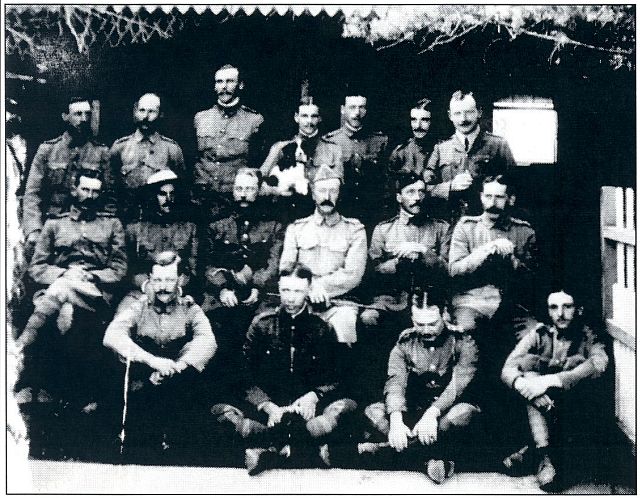
Officers of Lincolnshire Regiment at a Rietfontein farmhouse,
with Colonel Archdale in the centre.
(By courtesy: Second Battalion, Lincolnshire Life Museum, Lincoln).
On 11 June, the convoy marched at 09.00, whilst Allenby's column left at 07.30. That day the convoy only got just beyond the Nek. On the 13th, it took the convoy from 11.00 to 17.00 to cross the drift at Middel Kraal. The head of the convoy reached the camping ground at 19.00; the tail was spread out over 2 miles [3km] and took another 3½ hours to get in. The flank guards had to remain out until all had come in.
'First away was the mounted advance guard followed by the infantry advanced guard who were followed by the infantry main body and the guns [2]. Then, as the head of the convoy got on the move, the two flank guards each sent out a sub-section to keep level with and 800 yards [731 m] from the leading wagon; as the wagons continued moving off the flank guard [companies] would keep sending out sub-sections, reckoning those intervals by wagons, not by yards, that being the best way to tackle the concertina-telescopic qualities of the convoy. The leading man of the subsection would mark the wagon he moved off by and do his best to keep level with it. Hence if each subsection really watched its 'marker' wagon there would be less chance of any part of the convoy being uncovered by infantry, even if it did open and straggle out. The men in these flanking sub-sections moved in extended order, single file, so that in the event of an attack from their flank, each man had only to face the enemy and the sub-section was in position. Naturally they were not tied down to being 800 yards [731 m] from the convoy. The interval depended on the ground. Suspicious kopjes or rises had to be searched and not left unoccupied until the next sub-section was almost up to take over. The rearguard company covered the whole space between the tails of the two flank guards. Thus, it will be seen that we had a ring fence of infantry all around the convoy and outside of this there were mounted troops working' (Cameron Highlanders, 1903, p 134).
The Scots Greys
Amongst the troops in Allenby's column on 10 June were the Greys; their medical officer, Major A F Russell's diary states that 'we marched down the Magaliesberg valley [from Pretoria] to just opposite Silkaatsnek over the same road by which I took the wounded in July 1900 [after the battle of Silkaatsnek, 11 July 1900]. We camped at Rietfontein on the hill on which the HQ of the Scots Greys were camped the night of the attack on Zilikats Nek'.
'Immediately behind us marched a big convoy of 150 ox wagons and 45 mule wagons carrying 3 to 4 months' food for the garrison in Rustenburg. This convoy was strongly guarded by the Cameron Highlanders, two field guns and some 600 or 700 Yeomanry, including the corps that ran away from the Carabiniers on a previous trek.'
Kitchener got nervous at the last moment 'and suddenly ordered 200 Carabiniers to be taken from the Brigade to go with the convoy to Rustenburg to stiffen the Yeomanry if they had trouble. The convoy's departure was kept such a secret that the Rustenburg garrison did not know it was coming' (Maurice, 1908, Appendix V).
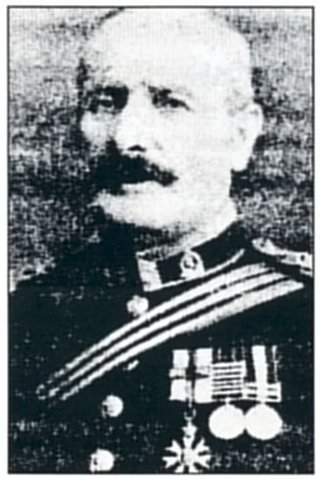
Major Russel, Medical Officer, Royal Scots Greys
(Source: Robertson, Cavalry Doctor, Constantia, 1975).
Major Russel's account continues: 'Revisiting Rietfontein was most interesting. We found a 200-bed hospital there with three nursing sisters and a garrison of 700 or 800 men. This large hospital out in an isolated place is for the reception of sick from the many columns coming and going. To our surprise we found the Lincolnshire Regiment there - the very regiment that had three companies captured with the Greys at Zilikats Nek.'
The Nek ' ... itself is not held as it is now seen to be a weak position for a small force, but Rietfontein, which is a small hill in the valley opposite the Nek and some 2 or 3 miles [5km] from it, is strongly entrenched with redoubts and wire entangles. They have got a 4.7-inch gun looking up into the Nek'.
'The garrison at Rietfontein is kept in supplies by four traction engines, each drawing four or five wagons. This sort of convoy is much easier to guard as it is not scattered along the road like ox or mule transport but, of course, it does not do well on steep hills or bad roads.'
Returning to Rietfontein on 18 August, the doctor notes that, '[we] camped in the valley opposite Commando Nek. Three companies of Inniskilling Fusiliers were left on top to guard the RE, while building four blockhouses there [five were built]. Every pass through the Magaliesberg is now held by us, but of course individual Boers could cross the hills between posts and even get horses over. The posts, however, prevent all wagons crossing and would make it dangerous for riders to cross if troops were in pursuit.'
'These small posts use up a great number of M[edical] O[fficer]s. Fortunately, a Civil Surgeon, Sandilands, arrived with a convoy the day before we marched and I left him at Damhoek [near Krugersdorp]. He had been sent to relieve Inkson who had been telegraphed to get his VC from the Duke at Maritzburg. [On 19 August] we crossed the Crocodile River and camped close to Rietfontein opposite Zilikats Nek. At Rietfontein there is a small canteen and we were able to buy a few things.'
When he visited a month later, the doctor observed that the Moot was a good deal colder than the northern side of the Magaliesberg, which was normally frost-free [Robertson, 1975, p 212].
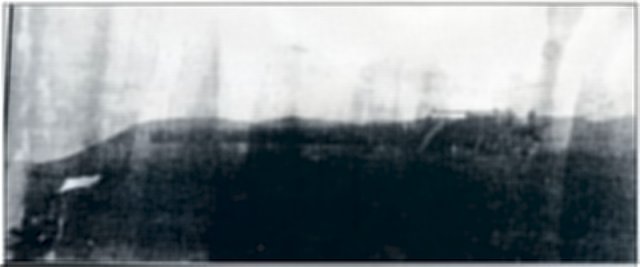
The 4.7-inch naval gun [silhouette] 'ooking up into the Nek' at Silkaatsnek
(Source: Clayton, 'Kitchener's Horse', Killie Campbell Museum, Durban).
Boer snipers
On 4 June Captain McAndrew, five officers and 200 NCOs and men proceeded to Kalkheuwel at 20.00 to co-operate with columns from Pretoria and Roodeval [near Johannesburg] from the south that were clearing the Schurveberg and Kalkheuwel. Col Hacket Thompson's column was to join forces with Col Frys at Rooi Krans, but before that could be done, the Boers were able to get their cattle clear to Kalkheuwel where they afterwards drew up a defensive position. Capt McAndrew's force retired at 14.30 and arrived at Rietfontein at 18.00 on the 26th. The threat must have been considered serious for, on the 28th, Major Day, with three officers and 200 men, proceeded to Kalkheuwel to establish a new post there and build a blockhouse. The area had been 'a great stronghold of Boer snipers for a long time.' Indeed, as late as October, 19-year old Bandsman Thurgood was mortally wounded by a sniper whilst on sentry duty in a trench at Rietfontein. He died after his leg had been amputated at the hospital.
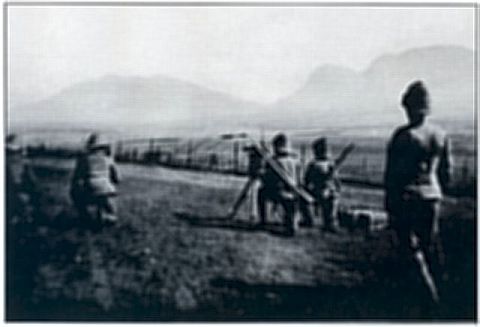
Machine-Gun Section, 'E' Company, Northumberland Fusiliers, contemporary photograph
by Lieutenant Gibbs (Source: Fusiliers Museum of Northumberland).
The blockhouses
By mid-July, several blockhouses and redoubts had been built at Kalkheuwel. They were manned either by two companies of Lincolns or one company and some South African Constabulary, who had also been co-operating with General Barton in clearing the area.
On the morning of 23 July, two companies that had marched out of Rietfontein to join General Barton, were sniped at 'Scrubies' Farm but had no casualties. [Members of the Scruby family still live in the area].
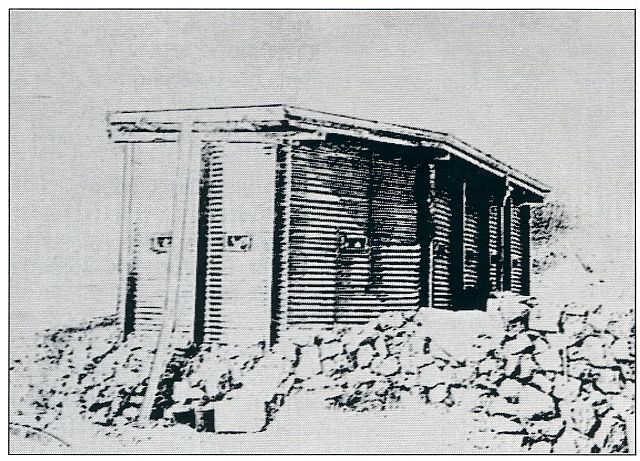
Drawing of a Rice-pattern fort at Silkaatsnek, c August 1901.
Note the lightning conductor (Source: Royal Engineers Library, Chatham).
It was thought necessary to establish a new fort at the nearby 'Orange Grove', where there were many citrus farms. Lieutenant Bastard, with 30 NCOs and men, was sent out to occupy the two small hills guarding the road from Johannesburg and to 'build a blockhouse there. Another blockhouse was built at Skeerpoort in the Moot and, by August, the drive to clear the Boers from the area round Rietfontein was completed. A chain of blockhouses was being constructed along the Magaliesberg by the Royal Engineers (RE) under the protection of three companies of Northumberland Fusiliers to ensure control of all the passes. This chain was completed by October and occupied by the Lincolns, involving some 560 men (Robertson, 1975, p 244). Colonel Archdale was appointed Commandant of all outlying post as far away as Nooitgedacht. The forts had telegraphic communications with the headquarters at Rietfontein, which was also connected to the hospital. The line reached as far as Rustenburg; South Hill and Fort Anderson had no telegraph according to the distribution map (see below), but would have been able to communicate by heliograph or semaphore with ease owing to the very rare cloud cover.
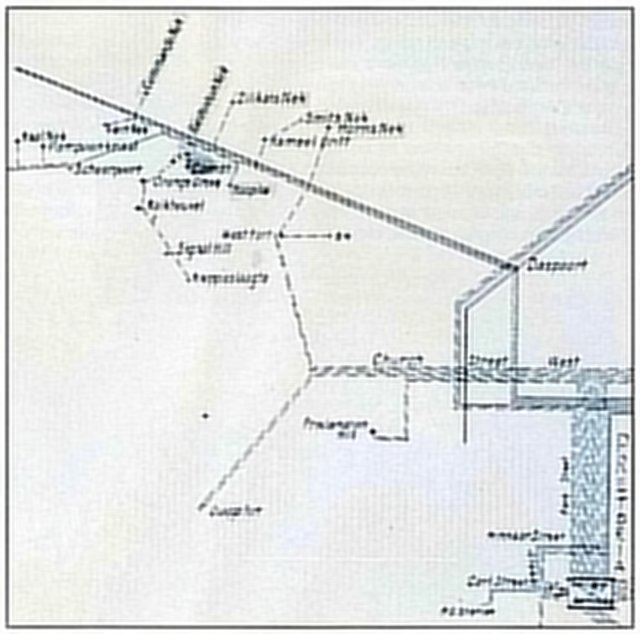
A diagram of the telephone lines at Rietfontein
(Source: Hippisley, History of Telegraphic Operations
in South Africa, HMSO, London, 1903).
Convoys were mainly destined to reach the garrison at Rustenburg for distribution of supplies further afield since it had a capacity half that of Rietfontein. Every attempt was made to keep convoy movements a secret from the Boers and, indeed, the forts on the hills to the south of Rietfontein denied the Boers that opportunity (Copley & Panagos, June 1998, p 22).
From 7 to 10 August, Col R G Kekewich's column moved eastwards along the northern side of the Magaliesberg. This column worked in conjunction with Colonel Allenby's on the southern side, capturing many prisoners. Kekewich halted for several days at Commando Nek, where he was resupplied from Rietfontein. On 19 August, Major Allenby also refitted there; he had 400 cavalry and two guns (Maurice, 1908, p 292). This coincided with the extra activity of blockhouse building and possibly upgrading Rietfontein with the availability of Rice-pattern material. The foundations of seven blockhouses have been found in the available areas of the complex.
A heavy thunderstorm on the night of 22 October caused a lightning strike at one of the Kalkheuwel blockhouses; several rifles were damaged, but no men were injured. Just a year previously, two men were killed by lightning. There were also two shooting incidents, one drowning and one suicide.
It was necessary, also in October, to increase the garrison at Pampoen [Pumpkin] Nek 'in order to prevent Boers from crossing the Magaliesberg to go south to the highveldt', which was the whole object of the Magaliesberg chain of forts. By November, the Lincolns were occupying sixteen separate forts, supported by 200 SA Constabulary with one gun at Hekpoort. In January 1902, an officer and 40 NCOs and men occupied four blockhouses at Horn's Nek, 15 km east of Rietfontein and only 10km from Pretoria.
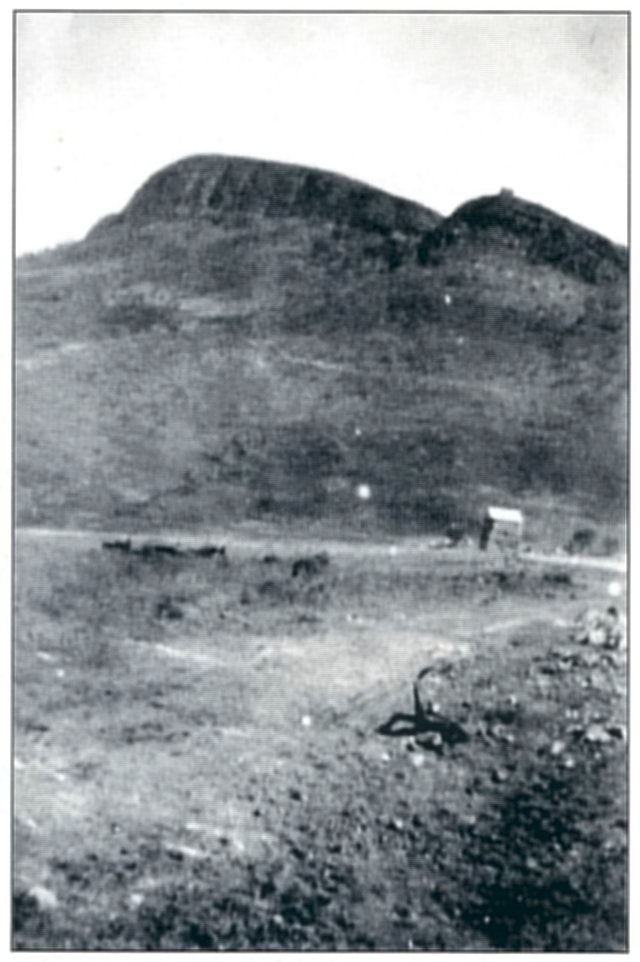
Blockhouse at Kommando Nek. Photograph by U Gibbs
(Source: Fusiliers Museum of Northumberland).
The final days
The quantities of 'rations' fixed early in 1902 as the prescribed supply reserves at Rietfontein were: 90 000 medical comforts, 19 000 rations of grain for the men and 60 000 rations of hay for the animals.
Rustenburg held rations for 50 000 men in the form of 5 000 medical comforts, 50 000 of grain and 25 000 of hay. Rustenburg eventually came under Western Johannesburg, whereas Rietfontein remained under the Pretoria Supply District (Maurice, 1908, Vol III, P 587).
At the end of March 1902, transfers to Barberton started. In June, orders were received 'that all blockhouses are to be held in readiness to be vacated and all reserve ammunition and entrenching tools are to be at once returned to store' (Digest of the Lincolnshire Regiment, p 34). It is assumed the Rietfontein Camp was abandoned from this date.
Bibliography
Primary Sources
Acknowledgements
Return to Journal Index OR Society's Home page
South African Military History Society / scribe@samilitaryhistory.org